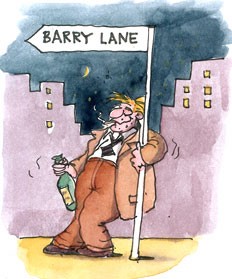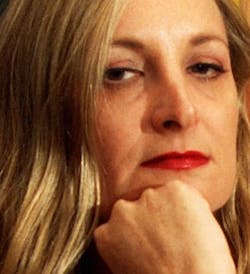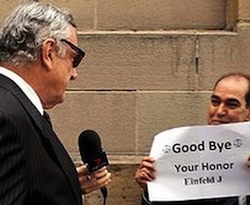Barry Lane tracks in exquisite detail the Kala Subramaniam case, which should have sounded a warning bell for The Mensch ... Alas ... From Justinian's archive, March 31, 2009
 WITH the recent potting of “National Living Treasure”, former Federal Court judge and lawyer extraordinaire, Marcus (The Mensch) Einfeld, I’m wondering whether the contagion of TINS (traffic infringement notice syndrome) is not only widespread in the general community but that it is a particular condition affecting lawyers in Sin City.
WITH the recent potting of “National Living Treasure”, former Federal Court judge and lawyer extraordinaire, Marcus (The Mensch) Einfeld, I’m wondering whether the contagion of TINS (traffic infringement notice syndrome) is not only widespread in the general community but that it is a particular condition affecting lawyers in Sin City.
The Mensch should have become inoculated to the disease as long ago as 2003 because that’s when he first appeared for 30-something aspiring lawyer, Kala Devi Subramaniam (now known as Kala Jackson) in the High Court seeking special leave to appeal from a conviction for making a false stat dec in relation to a camera-detected traffic offence.
Ms Subramaniam had become engulfed in an imbroglio not all that dissimilar to the one that ensnared The Mensch.
For young Kala it all started going downhill at 8.20 am on Monday, August 21, 1995 when a Beemer registered to bespoke Sydney criminal lawyer Leigh Johnson failed to stop at a controlled intersection at the corner of Crown and Albion Streets, Surry Hills. The Beemer was snapped by a red light camera.
On or about September 7, 1995 a traffic infringement notice landed at Johnson’s office. At that time, the solicitor had seven demerit points on her slate at the RTA arising out of infractions committed on January 14, 1994 and April 29, 1994.
Further, it appears that Johnson had racked up “fine default cancellations” of her driving licence on April 3, 1989, March 25, 1993 and July 19, 1994.
Although the offence on August 21, 1995 would not have led to cancellation of Johnson’s licence, it would have added another three or four demerit points to her tally, exacerbating an already delicate situation.
At the time, Subramaniam was the proud possessor of a clean demerits’ record.
After some initial confusion in the office as to who was driving the Beemer that fateful day, it emerged that legal clerk and law student Kala Subramaniam had taken the car to recover some files.
Photos of the infraction arrived at Johnson’s office in early February 1996, although there was uncertainty about who placed the order for them.
The photos did not reveal who was driving the car.
On February 29, 1996 Subramaniam sent a stat dec to the Infringement Processing Bureau saying she was driving the car.
Due to a number of mix-ups, Johnson ended-up wearing a conviction for the offence.
An appeal was launched in the District Court and on August 5, 1996 Subramaniam gave evidence exonerating her employer.
 Johnson: taped conversation rules inadmissible That should have been the end of the matter but as armed services people used say in WW11, “loose lips sink ships”.
Johnson: taped conversation rules inadmissible That should have been the end of the matter but as armed services people used say in WW11, “loose lips sink ships”.
On October 14, 1996 Subramaniam told a fellow law clerk how she and Johnson had fooled the authorities over the August 21, 1995 incident.
Someone in the office was aggrieved and tipped off the cops.
On December 6, 1996 another member of staff, wired by the wallopers, obtained admissions from Subramaniam that she was not the driver of the car.
Thereafter, followed committals of both Johnson and Subramaniam.
Johnson walked because the only evidence against her, being the taped conversation with Subramaniam, was ruled inadmissible.
Unfortunately, Kala was committed for trial on two counts, comprising the false statement made on February 29, 1996 and giving perjured evidence on August 5, 1996.
She faced trials on August 23, 1999 and April 24, 2002.
In the first trial the jury was unable to reach a verdict. In the second, which was a “special” trial under the Mental Health (Criminal Procedure) Act 1990 the false statement count was found proven by the jury and she was put on a bond.
Subramaniam appealed to the Court of Criminal Appeal but her appeal was dismissed on November 25, 2002.
It was at that point that the National Living Treasure galloped to the rescue and was able to have the jury verdict quashed by the High Court on November 10, 2004.
If ever there should have been a wake-up call for The Mensch it was his association with this case.
But did he take any notice? Not on your Nellie.
At the moment Einfeld, by now a former judge, was appearing in the High Court for Kala the pesky NSW Bar Association was telling him he was required to fulfill all the requirements to get himself a practising ticket, including PI and CPD.
After being persistently fobbed off by The Mensch bar CEO Philip Selth told him he would refer the matter to the bar council.
Einfeld was livid at the impertinence:
“I have your letter of today and am greatly upset and saddened by its contents. As I am again about to leave for overseas to assist oppressed and suffering peoples, and being without secretarial support have to type this letter myself in some haste.”
He went on to say that he is a “person of honour” and that he thought that his public work and profile “might bring some recognition, even lustre, to the NSW bar as an institution”.
 Einfeld: bringing lustre to the barBecause he was insulted by these penny ante requirements he withdrew his application for a practising certificate and asked Selth not to use the authority to draw on his credit card.
Einfeld: bringing lustre to the barBecause he was insulted by these penny ante requirements he withdrew his application for a practising certificate and asked Selth not to use the authority to draw on his credit card.
Although he was successful in the Court of Criminal Appeal on October 14, 2008 in having quashed counts in respect of traffic offences allegedly committed on September 4, 1999, February 4, 2003 and November 29, 2003, Einfeld was snared by one committed on January 8, 2006.
Interestingly, when he appeared for Subramaniam on her special leave application on November 14, 2003 the police say it was only 15 days later that he committed a camera-detected traffic offence on November 29, 2003.
Ditto for the main hearing in the High Court on April 29, 2004.
Nineteen days before, on April 10, 2004, The Mensch allegedly made a further false stat dec in relation to the camera-detected traffic offence committed on November 29, 2003.
The Crown claimed he had already made a false stat dec in relation to that alleged offence on February 10, 2004.
Perhaps the notional treasure was concentrating so hard on Subramaniam’s appeal that he lost sight of the relationship between her “issues” and his own.
Things haven’t gone all that well for Kala Subramaniam since her success in the High Court, although she was advised by the DPP in what was a rather nice Christmas present on December 23, 2004, that he proposed taking no further action against her in relation to the false stat dec charge.
Following completion of her law degree and being awarded a Bachelor of Legal Studies by Macquarie University in 2002, on June 6, 2003 she applied to the Legal Practitioners Admission Board for admission to practice.
Rather courageously she said in her application:
“I was the victim of a horrendous unjustified District Court matter over a ‘red light offence’. It ran for many years, for political reasons, at the expense of my health and career. Despite this I managed to complete my law degree.”
The board refused Subramaniam’s application and she appealed to the NSW Supreme Court.
In an extensive judgment delivered on December 5, 2006 Justice Peter Johnson dismissed the appeal.
HH said that he was satisfied that Subramaniam …
“made credible and reliable admissions to Ms Coughlan on December 6, 1996 to the effect that she had not been the driver of Ms Johnson’s motor vehicle at 8.20 am on August 21, 1995 and that she had taken steps to mislead the relevant authorities, including the District Court, by means of a statutory declaration and evidence given by her which suggested that she was the driver of the motor vehicle at that time.”
In so finding, Johnson said that Subramaniam’s characterisation of her recorded conversation on December 6, 1996 as “rubbish … gossip … fantasy … fiction [and] mindless garbage” was “glaringly improbable”.
HH was not impressed with either Subramaniam or her former employer as witnesses.
Ms Johnson’s denial that she was driving her car on August 21, 1995 should not, having regard to the totality of the evidence, be “given any real weight” according to HH.
In the result, Justice Johnson was not satisfied that Subramaniam was of good fame and character and otherwise suitable for the law caper.
For both The Mensch and Subramaniam that old aphorism from Sir Walter Scott comes to mind: “Oh what a tangled web we weave, when first we practice to deceive.”